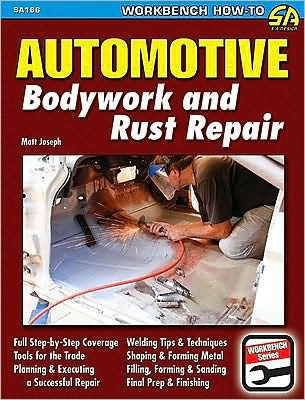

Paperback
-
PICK UP IN STORECheck Availability at Nearby Stores
Available within 2 business hours
Related collections and offers
Overview
In Automotive Bodywork and Rust Repair, veteran restorer Matt Joseph shows you the ins and out of tackling both simple and difficult rust and metalwork projects. This book teaches you how to select the proper tools for the job, common-sense approaches to the task ahead of you, preparing and cleaning sheet metal, section fabrications and repair patches, welding options such as gas and electric, forming, fitting and smoothing, cutting metal, final metal finishing including filling and sanding, the secrets of lead filling, making panels fit properly, and more. Also included is a comprehensive resource guide.
Whether you decide you want to tackle a full restoration project, or just want to save money by doing minor repairs yourself, Automotive Bodywork and Rust Repair is the book to get you through it.

Product Details
| ISBN-13: | 9781932494976 |
|---|---|
| Publisher: | CarTech |
| Publication date: | 10/05/2009 |
| Pages: | 160 |
| Sales rank: | 1,105,257 |
| Product dimensions: | 8.48(w) x 11.00(h) x 0.38(d) |
About the Author
Table of Contents
AcknowledgmentsIntroduction
Chapter 1: What You Should Know Before You Start
Panel Types, Configurations and Reinforcements
Autobody Steel
Plasticity and Elasticity
Work Hardening: The Metal Remembers
At the Factory and Afterward
Necessary Tools and Equipment
General Considerations
Chapter 2: Limits of Materials, Equipment and Skills
Inherent Advantages
Divide and Conquer
Chapter 3: Types of Jobs
Damage Repair
Small Rust Repairs
Small Patch Piece Welding Methods
Chapter 4: Cleaning, Modeling and Cutting
Preparing and Cleaning Sheetmetal
Cutting Panel Materials
Getting Shapes and Contours Right
Chapter 5: Forming, Fitting and Smoothing
Simple Tools and Equipment
Applying Plasticity/Elasticity, Work Hardening and Annealing
Hammering Techniques that Work
Bending, Beading and Prying
Power Forming
Pulling Approaches to Moving Metal
Smoothing, Stretching, Shrinking and Forming Operations
Chapter 6: Bumping to Move the Metal the Right Way
Chapter 7: Metal Finishing
Indicating, Feeling and Other Human Tools to Determine Panel Surfaces
Filing Done Right
The Art of Pick Hammering
The Disc Sanding Alternative
Chapter 8: Welding Body Metal
Types of Joints
Welding Smaller Pieces into Large Constructions
Fixturing
Electric Welding
Chapter 9: Filling
The Secrets of Lead Work
The Project
Applying Lead Filler Material
Applying Plastic Fillers
Chapter 10: Special Projects and Procedures
Fabricating a Splash Shield for a Ford Amphibian
Making Panels and Trim Fit
Quarter-Panel Replacement
Door Re-Skinning
Hanging Doors
Mounting and Adjusting Trim
Chapter 11: Before You Paint
The Danger from Behind
Chapter 12: Minor Rust Repair to a Fender Edge
The Approach
The First Step: Evaluation
Removing the Bad Metal
Planning and Modeling the Repair
Cutting and Forming the Metal Patches
Final Fitting
Welding Considerations
Cleaning, Positioning, Fixturing and Welding
Grinding the Weld Beads and Shrinking the Bulged Area
Final Steps before Filling
Tinning
Applying the Lead Filler
Shaping the Lead and Finishing the Job
Chapter 13: Repairing Collision Damage in a Decklid
The Approach
The Early Steps
Metal Finishing
Filling
Chapter 14: Sources and Resources
Local Sources
Non-Local Sources
Knowledge and Problem-Solving Resources
Appendix
Soldering Data
Colors of Steel at Different Temperatures
